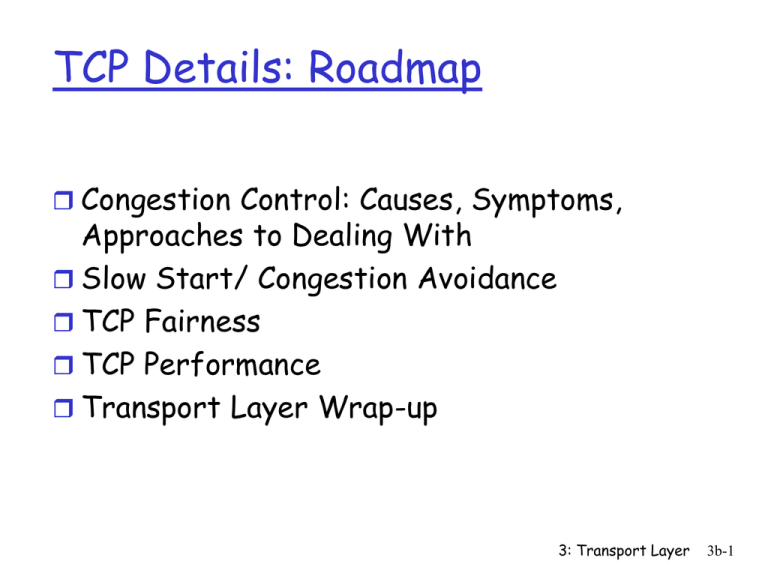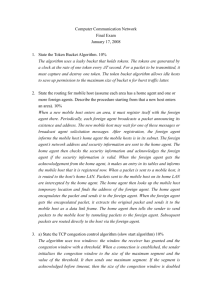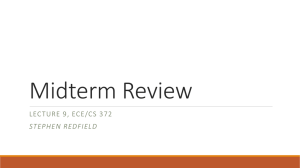Powerpoint
advertisement

TCP Details: Roadmap
Congestion Control: Causes, Symptoms,
Approaches to Dealing With
Slow Start/ Congestion Avoidance
TCP Fairness
TCP Performance
Transport Layer Wrap-up
3: Transport Layer
3b-1
Principles of Congestion Control
Congestion:
informally: “too many sources sending too much
data too fast for network to handle”
different from flow control!
a top-10 problem!
3: Transport Layer
3b-2
Congestion Signals
Lost packets:If there are more packets
than resources (ex. Buffer space) along
some path, then no choice but to drop some
Delayed packets: Router queues get full
and packets wait longer for service
Explicit notification: Routers can alter
packet headers to notify end hosts
3: Transport Layer
3b-3
Congestion Collapse
As number of packets entering network
increases, number of packets arriving at
destination increases but only up to a point
Packet dropped in network => all the
resources it used along the way are wasted
=> no forward progress
Internet 1987
3: Transport Layer
3b-4
Congestion Prevention?
In a connection-oriented network:
Prevent congestion by requiring resources to be
reserved in advance
In a connectionless network:
No
prevention for congestion, just reaction to
congestion (congestion control)
3: Transport Layer
3b-5
Causes/costs of congestion: scenario 1
two senders, two
receivers
one router,
infinite buffers
no retransmission
large delays
when congested
maximum
achievable
throughput
3: Transport Layer
3b-6
Causes/costs of congestion: scenario 2
one router, finite buffers
sender retransmission of lost packet
3: Transport Layer
3b-7
Causes/costs of congestion: scenario 2
l
=
l out (goodput)
in
“perfect” retransmission only when loss:
l > lout
in
retransmission of delayed (not lost) packet makes l
in
l
(than perfect case) for same
out
larger
“costs” of congestion:
more work (retrans) for given “goodput”
unneeded retransmissions: link carries multiple copies of pkt
3: Transport Layer
3b-8
Causes/costs of congestion: scenario 3
four senders
multihop paths
timeout/retransmit
Q: what happens as l
in
and l increase ?
in
3: Transport Layer
3b-9
Causes/costs of congestion: scenario 3
Another “cost” of congestion:
when packet dropped, any “upstream transmission
capacity used for that packet was wasted!
3: Transport Layer 3b-10
Approaches towards congestion control
Two broad approaches towards congestion control:
End-end congestion
control:
no explicit feedback from
network
congestion inferred from
end-system observed loss,
delay
approach taken by TCP
Network-assisted
congestion control:
routers provide feedback
to end systems
single bit indicating
congestion (SNA,
DECbit, TCP/IP ECN,
ATM)
explicit rate sender
should send at
3: Transport Layer 3b-11
Window Size Revised
Limit window size by both receiver
advertised window *and* a “congestion
window”
MaxWindow < = minimum (ReceiverAdvertised
Window, Congestion Window)
EffectiveWindow = Max Window - (Last
ByteSent - LastByteAcked)
3: Transport Layer 3b-12
TCP Congestion Control
end-end control (no network assistance)
transmission rate limited by congestion window size, Congwin,
over segments:
Congwin
3: Transport Layer 3b-13
Original: With Just Flow
Control
Destination
…
Source
3: Transport Layer 3b-14
TCP Congestion Control: Two
Phases
two “phases”
slow start
congestion avoidance
important variables:
Congwin: current congestion window
Threshold: defines threshold between two
slow start phase, congestion control phase
3: Transport Layer 3b-15
TCP congestion control:
“probing” for usable
bandwidth:
ideally: transmit as fast
as possible (Congwin as
large as possible)
without loss
increase Congwin until
loss (congestion)
loss: decrease Congwin,
then begin probing
(increasing) again
Don’t just send the entire
receiver’s advertised
window worth of data right
away
Start with a congestion
window of 1 or 2 packets
Slow start: For each ack
received, double window up
until a threshold, then just
increase by 1
Congestion Avoidance: For
each timeout, start back at
1 and halve the upper
threshold
3: Transport Layer 3b-16
“Slow” Start:
Multiplicative Increase
Source
Destination
Multiplicative Increase Up to the Threshold
“Slower” than full receiver’s advertised
window
…
Faster than additive increase
3: Transport Layer 3b-17
TCP Congestion Avoidance:
Additive Increase
Source
Destination
…
Additive Increase Past the Threshhold
3: Transport Layer 3b-18
TCP Congestion Avoidance:
Multiplicative Decrease too
Congestion avoidance
/* slowstart is over
*/
/* Congwin > threshold */
Until (loss event) {
every w segments ACKed:
Congwin++
}
threshold = Congwin/2
Congwin = 1
1
perform slowstart
1: TCP Reno skips slowstart (fast
recovery) after three duplicate ACKs
3: Transport Layer 3b-19
Fast Retransmit
Interpret 3 duplicate acks as an early
warning of loss (other causes? Reordering
or duplication in network)
As if timeout - Retransmit packet and set
the slow-start threshold to half the
amount of unacked data
Unlike timeout - set congestion window to
the threshhold (not back to 1 like normal
slow start)
3: Transport Layer 3b-20
Fast Recovery
After a fast retransmit, do congestion
avoidance but not slow start.
After third dup ack received:
threshold = ½ (congestion window)
Congestion window = threshold + 2* MSS
If more dup acks arrive:
congestion Window += MSS
When ack arrives for new data,deflate
congestion window:
congestionWindow = threshold
3: Transport Layer 3b-21
KB
Connection Timeline
70
60
50
40
30
20
10
1.0
2.0
3.0
4.0
5.0
6.0
7.0
8.0
9.0
Time (seconds)
blue line = value of congestion window in KB
Short hash marks = segment transmission
Long hash lines = time when a packet eventually
retransmitted was first transmitted
Dot at top of graph = timeout
0-0.4 Slow start; 2.0 timeout, start back at 1; 2.0-4.0 linear
increase
3: Transport Layer 3b-22
AIMD
TCP congestion
avoidance:
AIMD: additive
increase,
multiplicative
decrease
increase window by 1
per RTT
decrease window by
factor of 2 on loss
event
TCP Fairness
Fairness goal: if N TCP
sessions share same
bottleneck link, each
should get 1/N of link
capacity
TCP connection 1
TCP
connection 2
bottleneck
router
capacity R
3: Transport Layer 3b-23
Why is TCP fair?
Two competing sessions:
Additive increase gives slope of 1, as throughout increases
multiplicative decrease decreases throughput proportionally
R
equal bandwidth share
loss: decrease window by factor of 2
congestion avoidance: additive increase
loss: decrease window by factor of 2
congestion avoidance: additive increase
Connection 1 throughput R
3: Transport Layer 3b-24
TCP Congestion Control History
Before 1988, only flow control!
TCP Tahoe 1988
Congestion control with multiplicative decrease on
timeout
TCP Reno 1990
Add fast recovery and delayed acknowledgements
TCP Vegas ?
Tries
to use space in router’s queues fairly not
just divide BW fairly
3: Transport Layer 3b-25
TCP Vegas
Tries to use constant space in the router
buffers
Compares each round trip time to the
minimum round trip time it has seen to
infer time spent in queuing delays
Vegas in not a recommended version of TCP
Minimum time may never happen
Can’t compete with Tahoe or Reno
3: Transport Layer 3b-26
TCP latency modeling
Q: How long does it take to receive an object from a
Web server after sending a request?
TCP connection establishment
data transfer delay
Slow start
A: That is a natural question, but not very easy to
answer. Depends on round trip time, bandwidth,
window size (dynamic changes to it)
3: Transport Layer 3b-27
TCP latency modeling
Two cases to consider:
Slow Sender (Big Window): Still sending when ACK returns
time to send window
W*S/R
> time to get first ack
> RTT + S/R
Fast Sender (Small Window):Wait for ACK to send more data
time to send window
W*S/R
< time to get first ack
< RTT + S/R
Notation, assumptions:
O: object size (bits)
Assume one link between client and server of rate R
Assume: fixed congestion window, W segments
S: MSS (bits)
no retransmissions (no loss, no corruption)
3: Transport Layer 3b-28
TCP latency Modeling
Slow Sender (Big Window):
latency = 2RTT + O/R
Number of windows:
K := O/WS
Fast Sender (Small Window):
latency = 2RTT + O/R
+ (K-1)[S/R + RTT - WS/R]
(S/R + RTT) – (WS/R) = Time Till Ack Arrives –
Time to Transmit Window 3: Transport Layer
3b-29
TCP Latency Modeling: Slow Start
Now suppose window grows according to slow start (not slow
start + congestion avoidance).
Will show that the latency of one object of size O is:
Latency 2 RTT
O
S
S
P RTT ( 2 P 1)
R
R
R
where P is the number of times TCP stalls at server waiting
for Ack to arrive and open the window:
P min {Q, K 1}
- Q is the number of times the server would stall
if the object were of infinite size - maybe 0.
- K is the number of windows that cover the object.
-S/R is time to transmit one segment
- RTT+ S/R is time to get ACK of one segment
3: Transport Layer 3b-30
TCP Latency Modeling: Slow Start (cont.)
Example:
O/S = 15 segments
K = 4 windows
initiate TCP
connection
request
object
Stall 1
first window
= S/R
RTT
second window
= 2S/R
Q=2
Stall 2
third window
= 4S/R
P = min{K-1,Q} = 2
Server stalls P=2 times.
fourth window
= 8S/R
complete
transmission
object
delivered
time at
client
time at
server
3: Transport Layer 3b-31
TCP Latency Modeling: Slow Start (cont.)
S
RTT time from when server starts to send segment
R
until server receives acknowledg ement
initiate TCP
connection
2k 1
S
time to transmit the kth window
R
request
object
S
k 1 S
RTT
2
stall time after the kth window
R
R
first window
= S/R
RTT
second window
= 2S/R
third window
= 4S/R
P
O
latency 2 RTT stallTime p
R
p 1
P
O
S
S
2 RTT [ RTT 2 k 1 ]
R
R
k 1 R
O
S
S
2 RTT P[ RTT ] ( 2 P 1)
R
R
R
fourth window
= 8S/R
complete
transmission
object
delivered
time at
client
time at
server
3: Transport Layer 3b-32
TCP Performance Limits
Can’t go faster than speed of slowest link
between sender and receiver
Can’t go faster than
receiverAdvertisedWindow/RoundTripTime
Can’t go faster than 2*RTT
Can’t go faster than memory bandwidth
(lost of memory copies in the kernel)
3: Transport Layer 3b-33
Experiment: Compare TCP and
UDP performance
Use ttcp (or pcattcp) to compare effective
BW when transmitting the same size data
over TCP and UDP
UDP not limited by overheads from
connection setup or flow control or
congestion control
Use Ethereal to trace both
3: Transport Layer 3b-34
TCP vs UDP
What would happen if UDP used more than TCP?
3: Transport Layer 3b-35
Transport Layer Summary
principles behind
transport layer services:
multiplexing/demultiplexing
reliable data transfer
flow control
congestion control
instantiation and
implementation in the Internet
UDP
TCP
Next:
leaving the network
“edge” (application
transport layer)
into the network “core”
3: Transport Layer 3b-36
Outtakes
3: Transport Layer 3b-37
In-order Delivery
Each packet contains a sequence number
TCP layer will not deliver any packet to the
application unless it has already received
and delivered all previous messages
Held in receive buffer
3: Transport Layer 3b-38
Sliding Window Protocol
Reliable Delivery - by acknowledgments and
retransmission
In-order Delivery - by sequence number
Flow Control - by window size
These properites guaranteed end-to-end
not per-hop
3: Transport Layer 3b-39
Segment Transmission
Maximum segment size reached
If accumulate MSS worth of data, send
MSS usually set to MTU of the directly
connected network (minus TCP/IP headers)
Sender explicitly requests
If sender requests a push, send
Periodic timer
If data held for too long, sent
3: Transport Layer 3b-40
1)
To aid in congestion control, when a packet is
dropped the Timeout is set tp double the last
Timeout. Suppose a TCP connection, with window
size 1, loses every other packet. Those that do
arrive have RTT= 1 second. What happens? What
happens to TimeOut? Do this for two cases:
a.
After a packet is eventually received, we pick
up where we left off, resuming EstimatedRTT
initialized to its pretimeout value and Timeout
double that as usual.
b.
After a packet is eventually received, we
resume with TimeOut initialized to the last
exponentially backed-off value used for the
3: Transport Layer
timeout interval.
3b-41
Case study: ATM ABR congestion control
ABR: available bit rate:
“elastic service”
if sender’s path
“underloaded”:
sender should use
available bandwidth
if sender’s path
congested:
sender throttled to
minimum guaranteed
rate
RM (resource management)
cells:
sent by sender, interspersed
with data cells
bits in RM cell set by switches
(“network-assisted”)
NI bit: no increase in rate
(mild congestion)
CI bit: congestion
indication
RM cells returned to sender by
receiver, with bits intact
3: Transport Layer 3b-42
Case study: ATM ABR congestion control
two-byte ER (explicit rate) field in RM cell
congested switch may lower ER value in cell
sender’ send rate thus minimum supportable rate on path
EFCI bit in data cells: set to 1 in congested switch
if data cell preceding RM cell has EFCI set, sender sets CI
bit in returned RM cell
3: Transport Layer 3b-43
Sliding Window Protocol
Reliable Delivery - by acknowledgments and
retransmission
In-order Delivery - by sequence number
Flow Control - by window size
These properites guaranteed end-to-end
not per-hop
3: Transport Layer 3b-44
End to End Argument
TCP must guarantee reliability, in-order,
flow control end-to-end even if guaranteed
for each step along way - why?
Packets may take different paths through
network
Packets pass through intermediates that might
be misbehaving
3: Transport Layer 3b-45
End-To-End Arguement
A function should not be provided in the
lower levels unless it can be completely and
correctly implemented at that level.
Lower levels may implement functions as
performance optimization. CRC on hop to
hop basis because detecting and
retransmitting a single corrupt packet
across one hop avoid retransmitting
everything end-to-end
3: Transport Layer 3b-46
TCP vs sliding window on
physical, point-to-point link
1) Unlike physical link, need connection
establishment/termination to setup or tear
down the logical link
2) Round-trip times can vary significantly
over lifetime of connection due to delay in
network so need adaptive retransmission
timer
3) Packets can be reordered in Internet
(not possible on point-to-point)
3: Transport Layer 3b-47
TCP vs point-to-point
(continues)
4) establish maximum segment lifetime
based on IP time-to-live field conservative estimate of how the TTL field
(hops) translates into MSL (time)
5) On point-to-point link can assume
computer on each end have enough buffer
space to support the link
TCP must learn buffering on other end
3: Transport Layer 3b-48
TCP vs point-to-point
(continued)
6) no congestion on a point-to-point link -
TCP fast sender could swamp slow link on
route to receiver or multiple senders could
swamp a link on path
need
congestion control in TCP
3: Transport Layer 3b-49






